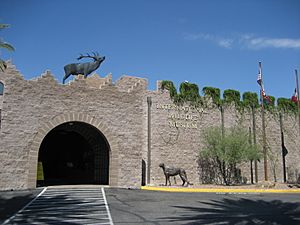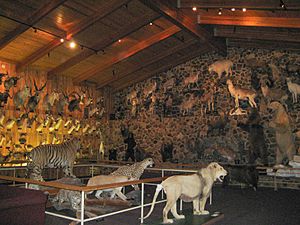International Wildlife Museum facts for kids
The International Wildlife Museum was a special museum in Tucson, Arizona, that focused on natural history. It was a place where you could learn all about different animals and their habitats. The museum first opened its doors in 1988. It was created by C. J. McElroy as a way to teach people about wildlife through the Safari Club International Foundation.
Sadly, the museum is no longer open. On January 11, 2024, the Safari Club International Foundation announced that the museum had closed for good.
Amazing Animal Displays
The International Wildlife Museum was quite large, covering about 40,000 square feet. Inside, it had displays of over 400 different kinds of birds, insects, and mammals. Some of the animal displays were very old, even more than 100 years old! These displays were often given to the museum by government groups or places that help animals.
The museum was famous for its `taxidermy` displays. Taxidermy is the art of preparing, stuffing, and mounting the skins of animals so they look like they are still alive. Many displays were `dioramas`, which are scenes that show animals in their natural environments. You could see mounted heads of animals too.
Some of the most exciting things to see included:
- "Big Terror," a tiger from India.
- A rhinoceros that was collected by former President Theodore Roosevelt.
- An Irish elk with huge antlers that stretched 13 feet wide!
- Penguins that were part of Richard E. Byrd's trip to the South Pole.
- A passenger pigeon, a bird that is now extinct.
- And even a woolly mammoth, a giant animal from the Ice Age.
Why the Museum Closed
The International Wildlife Museum had been temporarily closed for a while. Then, on January 11, 2024, the Safari Club International Foundation shared on social media and their website that the museum had permanently closed its doors on December 31, 2023.
The foundation explained that all events planned after that date were canceled. They also said they were working to return any animal displays that had been borrowed from other organizations. The rest of the museum's animal displays and exhibits were planned to be moved to new places. This way, they could continue to teach people about wildlife and how important it is to manage and protect animals. The Safari Club International Foundation thanked everyone who had supported the museum over the years, including visitors, members, volunteers, workers, and donors.



